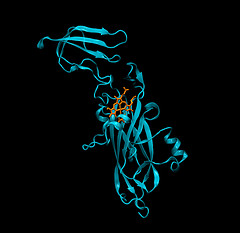INTRODUCTION:
Isolation of glycoproteins from protein solutions is routinely performed on concanavalin A (Con A) agarose (or sepharose). Con A is used for the purification of glycoproteins, polysaccharides and glycolipids as it binds molecules containing α-D-mannopyranosyl, α-D-glucopyranosyl and sterically related residues. Con A agarose has also be used in other application areas including purification of enzyme-antibody conjugates, purification of IgM and separation of membrane vesicles.
Con A is a metalloprotein and to maintain its binding characteristics the presence of both Mn2+ and Ca2+ is essential. Each subunit of Con A utilizes one calcium and one manganese ion and these cations can be removed under acidic conditions abolishing the carbohydrate-binding activity.
For the elution of bound molecules the preferred method is to use competitive eluents. Suitable eluents include, but a re not limited to:
- methyl-α-D-mannopyranoside [50-200mM]
- methyl-α-D-glucopyranoside [50-200mM]
Common Elution Techniques are Ineffective!
Researchers routinely report that they have issues with eluting their protein as seen by lower than expected yields. This reduced yield also reduces the column capacity.
The following conditions have been shown in published literature to help with the elution of tightly bound biomolecules. We recommend trying a combination of the following and optimizing for your specific protein or biomolecule:
- Paused Elution: Introduce one or more 5-10 minute pauses or incubations during the elution.
- Eluent Concentration: Explore increasing concentrations of competing ligand. We recommend 200-500mM as higher concentrations have been shown to be inhibitory.
- Eluent Ligand: The two primary competing ligands used are methyl-α-D-mannopyranoside and methyl-α-D-glucopyranoside. Changing from one competing lignand to a different one has been shown to improve elution for some proteins.
- Salt Concentration: The amount of salt (NaCl) in both the equilibration and elution buffer may have an effect on the elution of the biomolecule. Interestingly, reports have shown that the presence of sodium chloride can both improve and diminish elution of the biomolecule of interest. This is probably due to the hydrophobicity of the biomolecule involved, with salt helping elute hydrophilic biomolecules but having an opposite effect on hydrophobic molecules.
- Elution Buffer pH: Varying the pH of the elution buffer may help with the elution profile, however the choice of pH may be restricted by the biomolecule being eluted. Do not lower the pH below 4.0.
- Additional and/or Alternative Eluents:
- Chaotropes: 4-6M urea or guanidine.HCl have been used to increase the yield during elutions, however these chaotropes may permanently destroy the tetrameric structure of Con A. Chaotropes may also improve elution by essentially stripping the Con A from the agarose beads.
- Ethanol: 20% ethanol supplemented in the elution buffer has been reported to improve elution of some molecules, but also had no effect on others.
- Ethylene Glycol: A gradient wash with up to 50% ethylene glycol has been reported to eluent strongly bound glycoproteins.
- Borate: Borate is known to form complexes with cis-diols on sugar residues and can act as a competitive eluent, however there is conflicting success in the literature. This may be very biomolecule dependent
- Non Ionic Detergents: The use of <1% non-ionic detergents have been shown to have some success with certain biomolecules and proteins, but again this is very dependent on the biomolecule.
Sadly there is no perfect elution buffer for all proteins and biomolecules bound to Con A agarose and it is therefore the responsibility of the researcher to test and optimize their buffer and methodology with the above suggestions.








